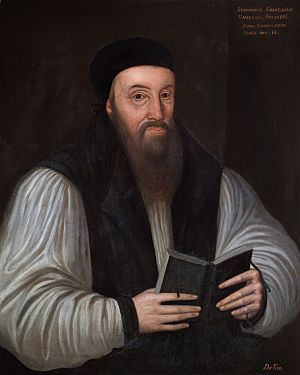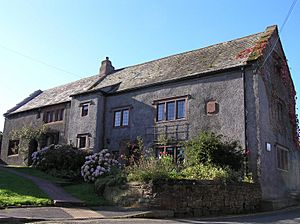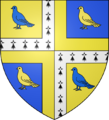Edmund Grindal facts for kids
Quick facts for kids The Most Reverend Edmund Grindal |
|
|---|---|
| Archbishop of Canterbury | |
 |
|
| Church | Church of England |
| Diocese | Canterbury |
| In Office | 1576–1583 |
| Predecessor | Matthew Parker |
| Successor | John Whitgift |
| Orders | |
| Consecration | 21 December 1559 by Matthew Parker |
| Personal details | |
| Born | c. 1519 St Bees, Cumberland |
| Died | 6 July 1583 (aged 63-64) London |
| Buried | Croydon |
| Alma mater | Christ's College, Cambridge |
Edmund Grindal (around 1519 – 6 July 1583) was an important leader in the Church of England during the time of Elizabeth I. He served as Bishop of London, Archbishop of York, and finally as Archbishop of Canterbury, which is the highest position in the English church.
Even though he was born far from the main centers of power, Grindal quickly rose through the church ranks. He became a strong supporter of Puritanism, a movement that wanted to "purify" the church and make it simpler. When Mary I became queen and brought back Catholicism, Grindal had to leave England. He found safety in other parts of Europe.
When Elizabeth I became queen, Grindal returned to England. He continued to rise in the church, eventually reaching its top position. The late 1500s were a time of big changes for the English church. Modern historians now see Grindal as a very important leader who helped shape the church's future.
Contents
Early Life and Education
Edmund Grindal was born around 1519 in Cross Hill House, St Bees, a small village in Cumberland. His father was a farmer. Grindal himself once wrote that his birthplace was a small house built by his father and brother.
He likely started his education at the nearby St Bees Priory. It's believed that Grindal and Edwin Sandys, who also became an important bishop, grew up together. They were very close, "like brothers."
Grindal went to Magdalene, Christ's, and Pembroke Hall at Cambridge University. He earned his first degree in 1538. He became a deacon in 1544 and was known for his debating skills.
Rising in the Church
Grindal's career advanced quickly thanks to important people like Nicholas Ridley and Sir William Cecil. When Ridley became Bishop of London, he made Grindal one of his assistants. Grindal soon became a chaplain to King Edward VI.
In 1552, he helped review important church documents called the Forty-Two Articles. In 1553, he was chosen to be the Bishop of London. However, King Edward VI died just a month later. This changed everything, as Mary I became queen and brought Catholicism back to England.
Time in Exile
Because of the religious changes under Queen Mary I, Grindal had to leave England. He went to Strasbourg and then Frankfurt in 1554. He was one of many English Protestants who left the country during this time.
While in Frankfurt, he tried to help settle disagreements among the English exiles. They argued about how much the church should be reformed.
Bishop of London
Grindal returned to England in January 1559, on the same day Elizabeth I was crowned queen. He quickly became a key figure in establishing the reformed English church. He helped revise the church's prayer book.
In July 1559, he became the Master of Pembroke Hall, Cambridge. Soon after, he was made Bishop of London, the role he had been chosen for years earlier. He even ordained John Foxe, who wrote famous stories about Christian martyrs.
Grindal had some concerns about certain church practices, like wearing special robes, which he felt were too similar to Catholic traditions. He also worried about the Queen's strong control over the church. However, he was firm in his Protestant beliefs.
He was not as strict as some other church leaders when it came to punishing Puritans, who wanted to make the church even simpler. London was a challenging area to govern as a bishop. Grindal tried to make people use the official church practices, which led to protests. In 1565, many nonconformists (those who didn't follow the rules) were suspended. This led to the formation of the London Underground Church, a group that met secretly. Grindal sometimes raided their services and put people in prison, but usually only for short periods.
Archbishop of York
In 1570, Grindal became the Archbishop of York. In this northern region, there were fewer Puritans, but more Roman Catholics. Grindal worked to make sure everyone followed the church's rules, and he did so with skill.
He was well-regarded, and even before the previous Archbishop of Canterbury died, important figures like Lord Burghley suggested Grindal as his successor. The famous poet Edmund Spenser also spoke highly of him.
Archbishop of Canterbury
Grindal was appointed Archbishop of Canterbury on 26 July 1575. This was the highest church office in England.
Lord Burghley wanted Grindal to be less harsh on moderate Puritans than his predecessor had been. Grindal tried to improve the church courts. However, his time as Archbishop was cut short by a disagreement with Queen Elizabeth I.
The Queen wanted Grindal to stop "prophesyings." These were meetings where Puritan clergy trained and discussed sermons. She even wanted him to discourage preaching. Grindal disagreed strongly. He wrote a long letter defending the prophesyings, saying he would rather "offend your earthly Majesty than to offend the heavenly majesty of God."
Because of his disobedience, Grindal was suspended from his duties in June 1577. He stood firm, and the Queen even considered removing him from his position entirely. She was convinced not to, but his suspension continued. Elizabeth then suggested he resign, but he refused. After apologizing to the Queen, he was reinstated in late 1582. However, his health was failing. He died on 6 July 1583 and was buried in Croydon Minster.
Legacy and Impact
After his death, Grindal was admired by Puritans who faced difficulties from later Archbishops. Writers like John Milton and William Prynne praised him as a "grave and pious man" and "the best" of Elizabeth's bishops. They saw him as a moderate leader who tried to avoid conflict.
However, some High Church leaders criticized Grindal. They felt he was too soft on Puritans and allowed them too much freedom.
In the late 1800s and early 1900s, many historians viewed Grindal as a weak leader. But in 1979, a new book by Patrick Collinson argued that Grindal was not weak. Instead, he had the support of other bishops and helped guide the English Church in the early 1600s.
Grindal left money to several colleges at Cambridge and Oxford universities. He also provided funds for the poor in various towns.
His most lasting legacy is the St Bees School, a free grammar school he founded in his home village of St Bees. He wrote detailed rules for the school just three days before he died. A school building was built by 1588, and it has provided education for over four centuries. Although it faced closure in 2015, it reopened in 2018.
Grindal also helped establish Highgate School in North London. He is even credited with bringing the tamarisk tree to Britain!
Images for kids



